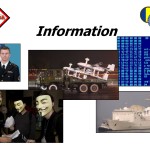
A 2013 training presentation from the U.S. Army TRADOC G-2 Intelligence Support Activity (TRISA) Hybrid Threat Train the Trainer course detailing information warfare concepts.

The Islamic State of Iraq and the Levant (ISIL) has risen to prominence as a danger to peace and a regional threat with global impact. This perception comes, in large measure, because of its successes in Syria and then a rapid takeover of northern Iraq. Its military victories are largely due to successful recruiting, intra-insurgent conflict, large cash reserves, and ineffective opponents. There is much to learn from how ISIL is fighting. The ready availability of recruits, many of whom are foreigners attracted to ISIL successes, and large amounts of money for payroll and purchasing war materiel are critical considerations, but it is also important to consider how ISIL is fighting on the ground.

The Assessing Revolutionary and Insurgent Strategies (ARIS) series consists of a set of case studies and research conducted for the US Army Special Operations Command by the National Security Analysis Department of The Johns Hopkins University Applied Physics Laboratory. The purpose of the ARIS series is to produce a collection of academically rigorous yet operationally relevant research materials to develop and illustrate a common understanding of insurgency and revolution. This research, intended to form a bedrock body of knowledge for members of the Special Forces, will allow users to distill vast amounts of material from a wide array of campaigns and extract relevant lessons, thereby enabling the development of future doctrine, professional education, and training.
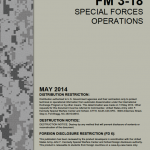
FM 3-18 is the principal manual for Special Forces (SF) doctrine. It describes SF roles, missions, capabilities, organization, mission command, employment, and sustainment operations across the range of military operations. This manual is a continuation of the doctrine established in the JP 3-05 series, ADP 3-05, ADRP 3-05, and FM 3-05.

TRADOC Pamphlet 525-3-1 describes how future Army forces, as part of joint, interorganizational, and multinational efforts, operate to accomplish campaign objectives and protect U.S. national interests. It describes the Army’s contribution to globally integrated operations, and addresses the need for Army forces to provide foundational capabilities for the Joint Force and to project power onto land and from land across the air, maritime, space, and cyberspace domains. The Army Operating Concept guides future force development through the identification of first order capabilities that the Army must possess to accomplish missions in support of policy goals and objectives.
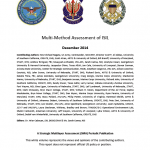
Early in 2014, as it became clear that the rise of the so-called “Islamic State” was becoming a significant menace to Regional Stability and US Interests, SOCCENT began a dialogue with Dr. Hriar Cabayan and his co-workers regarding a topic that has been at the core of the struggle against Violent Extremism. That question has been, and remains today, a perplexing one for those of us from Western cultures and societies: “What precisely are we contesting, and what is it that fuels the adversary’s power?” The contents of this paper reflect some of the work that Dr. Cabayan and his colleagues are doing to help us understand and comprehend this “intangible power” across a unique enterprise of academicians, scientists, policy intellectuals, current and former Foreign Service, military, and intelligence professionals. Most importantly, their efforts to improve our comprehension will enable us to adjust our efforts, our operations, our investments, and our risk-‐calculations to more effectively contest it and the organization that wields it. I am grateful for their tireless work in this regard, and I commend it to the reader.
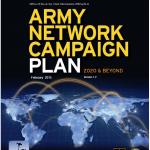
The world is evolving into an increasingly interconnected environment. The Army of 2020 will operate in a complex world where cloud-based computers receive data from tens of billions of devices. These computers will have the capacity to digest, correlate, contextualize, process and then present data back to humans in a way that assists our decision-making process. The Army is modernizing its network to prepare for the impending data-driven, cloud-based world, as depicted in Figure 1. While legacy networking architectures stored and protected data locally, cloud-based architectures will store and protect data in a centralized yet distributed repository that enables global access. The Army Network Campaign Plan outlines current efforts that posture the Army for success in a cloud-based world.
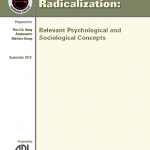
Radicalization is the process by which an individual, group, or mass of people undergo a transformation from participating in the political process via legal means to the use or support of violence for political purposes (radicalism). Radicalism includes specific forms, such as terrorism, which is violence against the innocent bystander, or insurgency, which is violence against the state. It does not include legal and/or nonviolent political protest, such as protest that is more properly called activism.
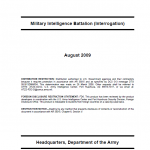
TC 2-22.304 provides doctrinal guidance concerning the military intelligence (MI) battalion (interrogation). The TC complements existing doctrine, in particular FM 2-22.3, and incorporates lessons learned from recent operations. The MI battalion (interrogation) is specifically designed to operate within a joint interrogation and debriefing center (JIDC). The battalion command, staff, personnel, and equipment form the nucleus of the JIDC. The battalion is task-organized and augmented with additional personnel from other Services, Government civilians, and civilian contractors to form a JIDC.
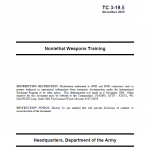
TC 3-19.5 provides guidance on specific NLW training with emphasis on User Training, Train-the-Trainer Training, and Unit Training. It is designed to be used with FM 3-22.40, Multi-Service TTP for the Tactical Employment of Nonlethal Weapons, and the Multi-Media Training Support Package (MMTSP). The MMTSP is a Warrior TSP designed to train individual tasks.
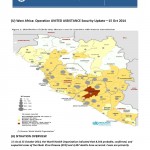
A collection of recent intelligence summaries for Operation United Assistance which is being conducted by U.S. Africa Command through U.S. Army Africa. The operation began in September and provides “coordination of logistics, training, and engineering support to the U.S. Agency for International Development (USAID) in West Africa to assist in the overall U.S. Government Foreign Humanitarian Assistance/Disaster Relief efforts to contain the spread of the Ebola Virus/Disease, as part of the international assistance effort supporting the Governments of Liberia, Sierra Leone and Guinea.”
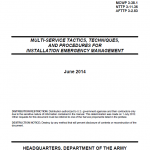
Multi-Service Tactics, Techniques, and Procedures for Installation Emergency represents a significant renaming and revision to the November 2007 publication Multiservice Tactics, Techniques, and Procedures for Installation CBRN Defense. It expands the scope from chemical, biological, radiological, and nuclear (CBRN) defense to all-hazards installation emergency management (IEM), including the management of CBRN events. This publication defines the roles of Department of Defense (DOD) installation commanders and staffs and provides the tactics, techniques, and procedures (TTP) associated with installation planning and preparedness for response to, and recovery from, hazards to save lives, protect property, and sustain mission readiness. The purpose of this publication is to summarize existing policies, responsibilities, and procedures for IEM programs at DOD installations worldwide for all hazards, as defined by DODI 6055.17, and to translate this policy into tactical terms applicable to military installation commanders.
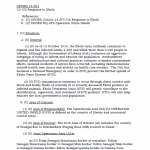
As of 15 October 2014, the Ebola virus outbreak continues to expand and has infected nearly 4,249 and killed more than 2,458 people in Liberia. Although the Government of Liberia (GoL) continues an aggressive campaign of trying to inform and educate the population, overburdened medical infrastructure and cultural practices continue to hinder containment efforts. Isolated incidents of unrest have occurred, including demonstrations outside health care clinics and attacks on health care workers. The GoL has declared a National Emergency in order to (IOT) prevent the further spread of Ebola Virus Disease (EVD).
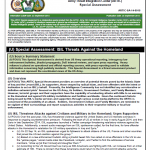
This ARTIC Special Assessment provides an overview of potential threats posed by the Islamic State of Iraq and the Levant (ISIL), its supporters, those swayed by radical Islam, and lone offenders with the intent or inclination to act on ISIL’s behalf. Presently, the Intelligence Community has not identified any corroborative or definitive extremist plots focused on the US Army, its Soldiers, Government Civilians, and Family Members. However, terrorist groups and their supporters have the capability of conducting attacks with little to no warning in the Homeland and against US military installations and facilities worldwide. Given the continued rhetoric being issued by ISIL’s media services and supporters through various social media platforms the ARTIC is concerned of the possibility of an attack. Soldiers, Government Civilians and Family Members are reminded to be vigilant of their surroundings and report suspicious activities to their respective military or local law enforcement.
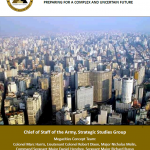
Cities with populations of ten million or more are given a special designation: megacity. There are currently over twenty megacities in the world, and by 2025 there will be close to forty. The trends are clear. Megacities are growing, they are be-coming more connected, and the ability of host nation governments to effectively deal with their explosive growth and maintain security is, in many cases, diminishing. Megacities are a unique environment that the U.S. Army does not fully understand.
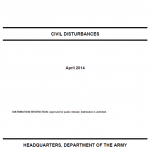
ATP 3-39.33 provides discussion and techniques about civil disturbances and crowd control operations that occur in the continental United States (CONUS) and outside the continental United States (OCONUS). United States (U.S.) forces deploy in support of unified action, overseas contingency operations, and humanitarian assistance worldwide. During these operations, U.S. forces are often faced with unruly and violent crowds who have the intent of disrupting peace and the ability of U.S. forces to maintain peace. Worldwide instability coupled with U.S. military participation in unified-action, peacekeeping, and related operations require that U.S. forces have access to the most current doctrine and techniques that are necessary to quell riots and restore public order.

Tactical Combat Casualty Care (TCCC) is the pre-hospital care rendered to a casualty in a tactical, combat environment. The principles of TCCC are fundamentally different from those of traditional civilian trauma care, which is practiced by most medical providers and medics. These differences are based on both the unique patterns and types of wounds that are suffered in combat and the tactical environment medical personnel face in combat. Unique combat wounds and tactical environments make it difficult to determine which intervention to perform at what time. Besides addressing a casualty’s medical condition, responding medical personnel must also address the tactical situation faced while providing casualty care in combat. A medically correct intervention performed at the wrong time may lead to further casualties. Stated another way, “good medicine may be bad tactics,” which can get the rescuer and casualty killed. To successfully navigate these issues, medical providers must have skills and training focused on combat trauma care, as opposed to civilian trauma care.
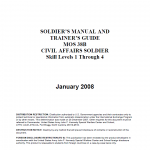
This manual provides the information necessary for Civil Affairs (CA) Soldiers to train for military occupational specialty (MOS) proficiency and includes self-development information that can assist the Soldier in lifelong learning and career development. An overview of the Army training process details the linkage and importance of the various elements that comprise the Army training process.